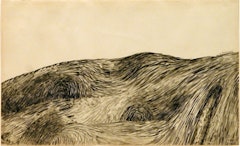Mabel Rodriguez
professor Doris Cacoilo
December 5, 2019
Post 4
Louise Bourgeois
 |
| Louise Bourgeois, “Untitled” (1950). Ink on paper. 14"× 22 ½". Courtesy Peter Blum Soho. |
Louise Bourgeois concentrate in paintings, printmaking. later, she moved to create sculptures in 1940. these photo call untitled it reflect in her hard life that she live with a father that prefer a son and a daughter. Louise Bourgeois she have her paintings and sculptures in MoMa.
Lynda Benglis
 |
| Lynda Benglis, ‘Wing.’ (Courtesy Cheim & Read) |
'Lynda Benglis is interest in gendered stereotypes extends to her pioneering videos. Works like Female Sensibility and Now (1973) play freely with arousal and submission, and questioned the role of the woman artist at the height of the feminist movement.'. This sculpture was made with 'layers of molten beeswax cling to a Masonite board'. she using metallic paintings and other knots.
Elizabeth Louise vigee le brun
Elizabeth Louise Theresia Czernin was a celebrity artist from 18-19 century Europe. She learned paint through her father until he died when she was young. later she continuing learning from copying artworks from public and private places.
Judy Chicago
Judy chicago is an feminist artist. she be attract to the women history that make her to create The dinner party with the helps of hundreds of volunteers during 1974 and 1979.' This monumental multimedia project, a symbolic history of women in Western Civilization, has been seen by more than one million viewers during its sixteen exhibitions held at venues spanning six countries. The Dinner Party has been the subject of countless articles and art history texts and is included in innumerable publications in diverse fields. The impact of The Dinner Party was examined in the 1996 exhibition, Sexual Politics: Judy Chicago’s Dinner Party in Feminist Art History. Curated by Dr. Amelia Jones at the UCLA Armand Hammer Museum, this show was accompanied by an extensive catalogue published by the University of California Press. Jones’ analysis has been updated and expanded in historian Jane Gerhard’s book The Dinner Party: Judy Chicago and the Power of Popular Feminism, 1970-2007, published by the University of Georgia Press. In 2007, The Dinner Party was permanently housed at the Brooklyn Museum as the centerpiece of the Elizabeth A. Sackler Center for Feminist Art, thereby achieving Chicago’s long-held goal. Recently, Chicago published a final updated book, The Dinner Party: Restoring Women to History (The Monacelli Press, 2014).'
Lee Krasner
| portrait of countess Maria Theresia Czernin, 1793 By Elizabeth Louise Vigee Le Brun |
Elizabeth Louise Theresia Czernin was a celebrity artist from 18-19 century Europe. She learned paint through her father until he died when she was young. later she continuing learning from copying artworks from public and private places.
Judy Chicago
| Judy Chicago's the dinner party |
Judy chicago is an feminist artist. she be attract to the women history that make her to create The dinner party with the helps of hundreds of volunteers during 1974 and 1979.' This monumental multimedia project, a symbolic history of women in Western Civilization, has been seen by more than one million viewers during its sixteen exhibitions held at venues spanning six countries. The Dinner Party has been the subject of countless articles and art history texts and is included in innumerable publications in diverse fields. The impact of The Dinner Party was examined in the 1996 exhibition, Sexual Politics: Judy Chicago’s Dinner Party in Feminist Art History. Curated by Dr. Amelia Jones at the UCLA Armand Hammer Museum, this show was accompanied by an extensive catalogue published by the University of California Press. Jones’ analysis has been updated and expanded in historian Jane Gerhard’s book The Dinner Party: Judy Chicago and the Power of Popular Feminism, 1970-2007, published by the University of Georgia Press. In 2007, The Dinner Party was permanently housed at the Brooklyn Museum as the centerpiece of the Elizabeth A. Sackler Center for Feminist Art, thereby achieving Chicago’s long-held goal. Recently, Chicago published a final updated book, The Dinner Party: Restoring Women to History (The Monacelli Press, 2014).'
Lee Krasner
 |
| Lee Krasner, The Springs, 1964; Gift of Wallace and Wilhelmina Holladay; © 2012 The Pollock-Krasner Foundation / Artists Rights Society (ARS), New York |
Lee Krasner have diferents way of create paintings ones of them is 'In The Springs, she combined the vocabulary of circles, ovals, and chevron shapes that she first developed.'
worked cited
https://www.moma.org/artists/471
https://www.judychicago.com/about/biography/
https://nmwa.org/works/springs
https://www.judychicago.com/about/biography/
https://nmwa.org/works/springs
No comments:
Post a Comment